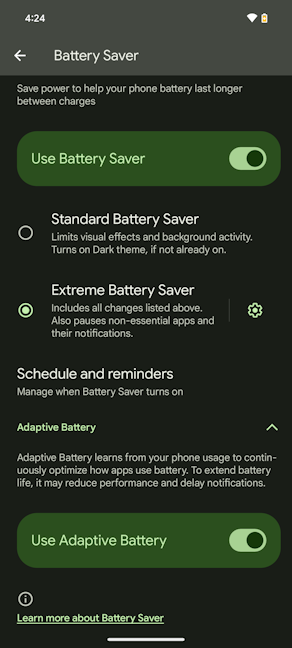
All Android smartphones and tablets have a battery-saving feature that you can activate manually or automatically to give you a little more time until the battery discharges completely. Google names it Battery Saver, but it may have different names (Power Saving, Power Saving Mode, etc.), depending on the device you’re using, its Android version, and manufacturer. If you want to save energy on your device, you don’t need to install a Battery Saver app; all you need to do is enable and configure the built-in Battery Saver feature on your Android smartphone or tablet, like this:
Does Android have a Battery Saver feature?
Battery Saver is a power saving mode available on Android smartphones and tablets, which aims to limit power consumption and prolong battery life. By default, this mode can be set to turn on automatically when your battery reaches 20%, but it can also be started manually at any time or set to activate itself automatically when the battery reaches a level of your choosing. When it’s turned on, Battery Saver can give you a few more hours of battery life.

Battery Saver on Android
Google has built Battery Saver into Android for its Google Pixel lineup of phones and tablets. However, most manufacturers have adopted this feature, and either left it as Google created it, or customized it and changed its name, features, or both. As a result, you can encounter the same Battery Saver feature on smartphones from many other manufacturers. For example, Samsung has renamed this feature Power saving and adjusted its capabilities. Realme changed this feature’s name to Power Saving Mode, while others, like OnePlus, Xiaomi, or Motorola, left it as Battery Saver and adjusted the way it works. The name of this feature is not that important, and you should expect it to do mostly the same things on all Android smartphones and tablets.
You should turn the Battery Saver on when you’re low on battery and can’t charge your device, or even when you're about to go on a lengthy trip, and you want to maximize how long the battery lasts.
What does Battery Saver do on your Android device?
The way the battery saving is implemented on your device depends on the Android version you’re using, and on how the device manufacturer has changed its algorithms and features. Google has developed two Battery Saver modes: standard and extreme.
Standard Battery Saver is the most common on Android phones and tablets, regardless of their manufacturer. When enabled, it does the following:
- The brightness of the screen is lowered by 10% or more.
- If the display of your device has a high refresh rate of 90 Hz or 120 Hz, the refresh rate is lowered to 60 Hz.
- Dark Mode is enabled on your Android device, so the display consumes less energy.
- Android apps refresh their content (email, news, weather, etc.) only when you open them.
- Location services (like GPS tracking) are stopped when the screen is turned off.
- 5G mobile connectivity is turned off and replaced by 4G.
- Android apps don’t run in the background unless you turn off Battery Saver. Unfortunately, this also means background synchronization doesn’t work, including cloud data backups through OneDrive, Google Drive, Dropbox, and other similar services.
- The Always On Display feature is disabled. The same goes for the ability to always show the time, date, and unread notifications on the lock screen.
- Your smartphone or tablet doesn’t listen for “OK Google” voice commands. If you want to use voice commands, you need to manually start Google Assistant or Gemini and interact with it.
- Low priority app notifications are delayed, to save energy.
- The Motion Sense feature available on some smartphones and tablets, which allows you to use gestures to perform actions without unlocking the screen, is turned off.
- The car crash detection is turned off on smartphones with this feature (like the Google Pixel 3 or newer models).
Extreme Battery Saver does everything the standard mode does, while adding the following limits:
- The speed of your device’s processor is lowered to consume less energy.
- Wi-Fi and Bluetooth scanning for location data get turned off. However, both Wi-Fi and Bluetooth connectivity remain available if the user turns them on.
- The display of your device is set to timeout after 30 seconds.
- Any active hotspot or tethering is stopped.
- All non-essential apps are paused and won’t send notifications. This includes the Google app.
- The leftmost page of the Home Screen, which usually displays the Google feed with personalized news and information, is no longer available. If you want to use it, you must unpause the Google app.
- Your work profile is turned off. You can use only the personal profile on your Android device.

Android has an Extreme Battery Saver too
How to enable or disable Battery Saver on Android devices
If you’re using a Pixel device from Google, a smartphone from Xiaomi, Motorola, or another vendor that uses the built-in options from Android, enabling or disabling Battery Saver works like this:
How to quickly turn on Battery Saver on Android
The fastest approach is to access the Quick Settings menu by swiping down from the top side of the screen. The Battery Saver option is probably not shown in the first row of Quick Settings shortcuts.

Swipe down to reveal Quick Settings
TIP: On Xiaomi smartphones, you need to swipe from the top-right area of the screen (swiping from the top-left gives you only the notifications).
In this compact view, swipe down again to access the expanded Quick Settings. Then, scroll through the list of quick settings until you find the Battery Saver icon and tap on it.

Swipe down one more time and turn on Battery Saver
On some smartphones, you may see a prompt which informs you about what Battery Saver does. Read the information and choose Turn on. The Battery Saver icon becomes lit to signal that this feature is active.
How to turn off Battery Saver on Android
The fastest way to disable Battery Saver is through the Quick Settings menu. Swipe down from the top side of the screen. If the Battery Saver icon is not shown, swipe down again to access the expanded Quick Settings. Then, scroll through the list of quick settings until you find the Battery Saver icon, and tap it to disable it.

Swipe down twice and turn off Battery Saver
TIP: Under the Battery Saver text, you also see which of the two modes (Standard or Extreme) is active, as shown in the screenshot above.
How to enable, disable, configure, and schedule Battery Saver from Settings
If you want more control over Battery Saver and to configure how it works, it is better to access it from Settings. Therefore, open the Settings on your Android device, scroll down the categories of settings until you find Battery, and tap it.

Go to Settings > Battery
Your Android device displays battery-related information and several settings. One of the entries shown is named Battery Saver. Under it, you see whether it is On or Off. Tap Battery Saver.
TIP: On some smartphones, like those made by Motorola, you see a switch next to Battery Saver. Don’t tap the switch, tap the text instead.

Tap Battery Saver
You see all the options available for the Battery Saver. Remember that they vary depending on your specific version of Android, your device, and who manufactured it. The options shown in my screenshots are from a Pixel phone made by Google, with Android 14. What you see may be different.
In most situations, you see a switch named Use Battery Saver. It can be turned on or off by tapping it. Under the switch, you can choose which exact mode you want to use: Standard Battery Saver or Extreme Battery Saver.

Choose the Battery Saver mode
If you choose Extreme Battery Saver, you can tap the Settings cogwheel icon next to it, to personalize it. First, you see a list of apps that are deemed essential by Google. The list is very short, as shown below.

The Essential apps chosen by Google
Scroll down to see all the other apps installed on your Android device. If you want to add an app to the list of essential apps, simply tap the plus sign (+) next to it. For example, I added Bitwarden to my essential apps because I need it to automatically complete passwords for me, even when I’m using Extreme Battery Saver. Repeat the process for the apps that are important to you. Remember to keep this list short, however, so that you can benefit from an extended battery life. To get back to the Battery Saver screen, tap the Back arrow in the top left.

Adding apps to the Essential apps list
Next, you can also schedule Battery Saver to turn on and off automatically, using the rules you set. To do that, tap Schedule and reminders first.

Tap Schedule and reminders
You see the following switches:
- Turn on based on battery level - turn on this switch, and then set the minimum battery level when you want the Battery Saver turned on. I recommend you use a level higher than the default 20%. Use the slider and switch to a value like 25% or 30%.
- Turn off at 90% - you may not want the Battery Saver turned on at all times. You should enable this switch to have the Battery Saver also turn off automatically when you charge your phone or tablet.
- Battery Saver reminders - if you didn’t turn on the first switch, I highly recommend you at least turn on this third switch. When it’s enabled, Android reminds you when the battery is low and asks you to activate Battery Saver, so it can last longer.

Set up how you want Battery Saver to turn on and turn off
One last setting that can be enabled is Adaptive Battery. Tap on this setting to expand it, and then enable the Use Adaptive Battery switch. When this option is turned on, Android learns which apps you use less often, and it makes them run less in the background, to save battery and increase how much your phone or tablet lasts on a single charge.

Turn on the Use Adaptive Battery switch
When you’re done setting up Battery Saver, close the Settings app.
TIP: Here’s how to show the battery percentage on Android smartphones and tablets.
Are you using the Battery Saver on your Android device?
Now you know what the Battery Saver is on Android devices, what it does, how it works, and its many names. You also know how to enable and turn off Battery Saver. Before closing this tutorial, tell me whether you like how the Battery Saver works on Android devices, and whether you use it regularly. Don’t hesitate to access the commenting options found at the bottom of this article and share your perspective.


 10.10.2024
10.10.2024 

